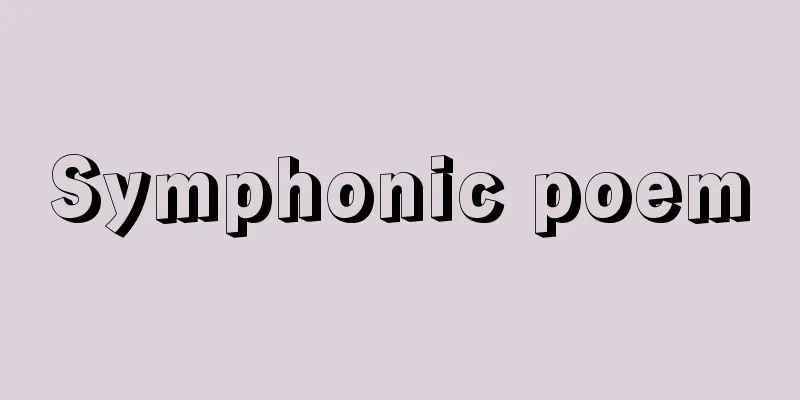Symphonic poem

|
A type of program music for orchestra that is based mainly on poetic or pictorial content. It is usually used for music with a single movement to distinguish it from multi-movement program symphonies based on a title. Titled orchestral music was already seen around 1700, but the term symphonic poem was first used in Liszt's performance of Tasso in Weimar (1854). Liszt left behind 13 symphonic poems based on literature and paintings, such as "What I Heard on the Mountain" and "Mazeppa" based on Hugo's poems, "Hamlet" based on Shakespeare's poems, and "Les Preludes" based on Lamartine's poems, and is considered the first composer of this genre. However, this type of musical work, which is linked to Romanticism, which prefers the subjective expression of literary, historical, and pictorial things, can be seen as a precursor to Liszt's works such as Beethoven's "Egmont Overture" and Mendelssohn's "Fingal's Cave Overture". Liszt developed the fixed idea technique used by Berlioz in his program symphonies such as Symphonie Fantastique, alluding to literary and pictorial content with a set idea, and using it as an element to give variety and unity to the piece. After Liszt, symphonic poems became associated with nationalism, and the content was the history and climate of one's own country, as exemplified by Smetana's symphonic poem cycle My Country. In addition, with the expansion of the orchestra and its functions, Richard Strauss and Debussy produced works incorporating color effects. [Yoshio Miyama] Source: Shogakukan Encyclopedia Nipponica About Encyclopedia Nipponica Information | Legend |
|
おもに詩的ないし絵画的内容に基づいてつくられた管弦楽のための標題音楽の一種。通常は、標題に基づいた多楽章の標題交響曲などと区別するため、単一楽章の音楽に対して用いられる。標題付きの管弦楽曲はすでに1700年前後にみられるが、交響詩という語が使われたのは、リストの『タッソー』のワイマールにおける演奏(1854)が最初である。リストは、ユゴーの詩による『山上にて聞きしこと』『マゼッパ』、シェークスピアによる『ハムレット』、ラマルチーヌの詩による『レ・プレリュード(前奏曲)』など、文学、絵画に基づいた交響詩を13曲残し、このジャンルの最初の作曲家とされる。しかし文学的、歴史的、絵画的なものの主観的表出を好むロマン主義と結び付いたこの種の音楽作品は、リスト以前にベートーベンの『エグモント序曲』、メンデルスゾーンの『フィンガルの洞窟(どうくつ)序曲』などにその先駆をみることもできる。リストは、ベルリオーズが『幻想交響曲』などの標題交響曲で用いた固定楽想の手法を用いて発展させ、文学的・絵画的内容を一定の楽想を用いて暗示するとともに、曲に変化と統一を与える要素として活用した。リスト以後、交響詩は国民主義と結び付いて、スメタナの連作交響詩『わが祖国』に代表されるように、自国の歴史や風土が内容となった。また、管弦楽やその機能の拡大に伴い、リヒャルト・シュトラウス、ドビュッシーにより、色彩的効果を盛り込んだ作品が生み出された。 [美山良夫] 出典 小学館 日本大百科全書(ニッポニカ)日本大百科全書(ニッポニカ)について 情報 | 凡例 |
<<: Xingjiao Temple (English name)
>>: Public Services - Public Services
Recommend
IMW - I M D B L
...From the 17th century to the end of the 19th c...
Limelight (English spelling)
An intense white light is emitted when an oxyhydro...
Tsunamasa Ikeda
1638-1714 A daimyo from the early to mid-Edo peri...
Itto Seiden Muto Ryu
One of the schools of swordsmanship. It was founde...
Shibusawa Zaibatsu
The bank was formed by companies centered around t...
Ankake porridge - Ankake porridge
...Ankake tofu is made by boiling tofu in kelp st...
Khlynov
...Population: 491,200 (1992). Founded in 1181 as...
No - No
Ears (also called "ears"). No Hon" ...
Dormition Cathedral (Moscow) - Usupenskii-seido
...The Kremlin took on the form we see today betw...
Clinical testing - medical technology
A branch of medicine that deals with various analy...
Shinhan Corporation - Shinkan Corporation
In 1945, after South Korea was liberated from Japa...
Interchange - Interchange (English spelling)
An intersection of roads is three-dimensional, an...
Karl Friedrich
… [history] The Margraviate of Baden was formed u...
Tonaki Island
One of the Okinawa Islands, this island is locate...
Venus's girdle - Venus's girdle
A ctenophore (illustration) of the family Ophiopho...







![Kisa [town] - Kisa](/upload/images/67cb50686875a.webp)

